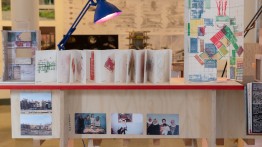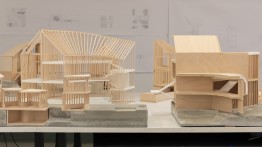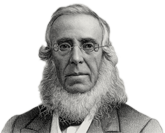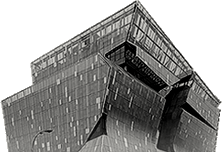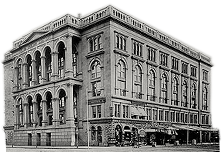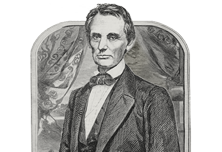Curriculum
Bachelor of Architecture Professional Degree
The School of Architecture offers a five-year program leading to a Bachelor of Architecture, a professional degree accredited by the National Architectural Accrediting Board (NAAB). The School’s architecture curriculum is designed to prepare students for diverse opportunities in the profession, offering a broad cultural and intellectual foundation in the liberal arts vis-à-vis the design of environments across all scales. The discipline of architecture interpreted as a cultural practice anchors a well-rounded education at the undergraduate level. Students develop their knowledge and design skills within a framework of studios and courses that stimulate research and debate into the nature and role of architecture as a cultural practice with profound social and environmental implications.
The content of the curriculum, based on a wide cultural view of architecture, reflects broad ethical values. Faculty-student interaction is conducted on an intensive basis in the design studio and other classes. Within this framework, faculty encourage students to develop their individual interests and strengths, with a recurring emphasis on and basic commitment to design fundamentals. This is intended to equip graduates with a lasting ability to produce architectural design that is a meaningful synthesis of social, aesthetic, and technological considerations. The relationship between architecture and other creative disciplines is stressed across all five years of study. Students are encouraged to express themselves both verbally and visually.
In a moment when the role and scope of the architect is rapidly assuming new dimensions in social and technological domains, the School emphasizes design principles and their underlying human values while preparing students to respond positively to change. Cooper’s program seeks to engender a strong sense of the responsibilities of service and leadership, teamwork, and individual creativity essential to developing principled professionals dedicated to interpreting and constructing the spatial needs of their communities. The five-year undergraduate design sequence is carefully structured to introduce students to the principles of architectonics, the investigation of program and site, structures, and environmental and building technologies, in a comprehensive and integrated curriculum. Design studios introduce the basic elements of form, space, and structure; complex institutional design problems in their urban context; and a year-long thesis that demonstrates the student’s ability to synthesize a comprehensive understanding of architecture in society. The essential skills of drawing, model-making, and design development are complemented by analytical and critical uses of digital technologies. Study of world architecture and urbanism is deepened by an understanding of individual cultures and environmental and technological issues at every scale. The theory of the discipline, past and present, is investigated through a close analysis of critical texts and related to the theory and practice of other arts, such as public art, film, and video. The position of the School of Architecture, together with the School of Art, the Albert Nerken School of Engineering, and the Faculty of Humanities and Social Sciences, offers a unique opportunity for interaction and interdisciplinary research and experience.
The Cooper Union’s location in New York City, in the heart of downtown Manhattan, provides a stimulating professional, social, and cultural context for the education of an architect, as well as an urban laboratory for the study of design in society. The city’s numerous cultural institutions provide an inexhaustible resource for research and experience outside the studio and classroom.
The school’s faculty includes nationally and internationally recognized architects, and its diverse student body consists of highly talented and motivated individuals; its distinguished alumni are leaders in architecture and related fields.
For additional information about Cooper Union's Bachelor of Architecture program, click here.
Master of Science in Architecture Post-Professional Degree
The Master of Science in Architecture (M.S.Arch.), formerly known as Master of Architecture II, is the School’s post-professional degree program. Launched in 2009, The Cooper Union’s M.S.Arch. program extends the vision and intellectual rigor of the School’s undergraduate program and advances its preeminent role in the education of architects. The program is open to applicants with a professional degree in architecture (Bachelor of Architecture or Master of Architecture I) from a NAAB-accredited program or an equivalent accrediting agency abroad.
The core of the M.S.Arch program is two semesters of studio-based design research culminating in a thesis project in the third semester. The program offers opportunities for advanced research in an enlarged field of inquiry, enabling students to craft their own agenda across diverse areas of study over three consecutive semesters: fall, spring, and fall. The three concentrations—theory, history, and criticism, urban studies, and technologies—provide a backbone for individual research that often spans the three areas of focus.
In addition, graduate-level seminars and workshops offer an intensive one-year immersion in the criticism, history, and theory of architecture and urbanism. Emphasis is placed on approaches to architectural analysis and history, the role and contemporary relevance of theory, and the social/political relations between theory and design. Seminars prepare students for careers in teaching by providing a broad understanding of the cultural conditions of architectural production and concentrating on excellence in writing and developing pedagogy. Analysis studios offer deep insight into the formal and programmatic diversity of historical and contemporary architecture, the process of design, and potential avenues for new approaches to theory and practice. An emphasis on technologies of representation allows for deeper investigations into specific areas of historical or contemporary architectural theory and ever-evolving developments in fabrication and computation.
For additional information about Cooper Union's Master of Science in Architecture program, click here.



